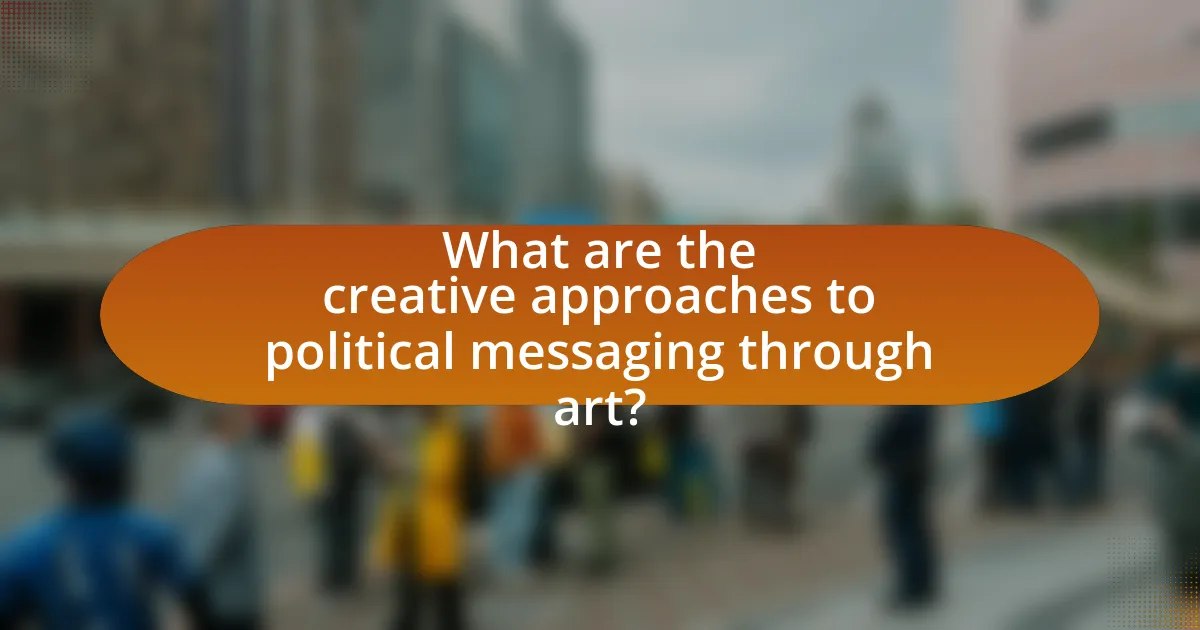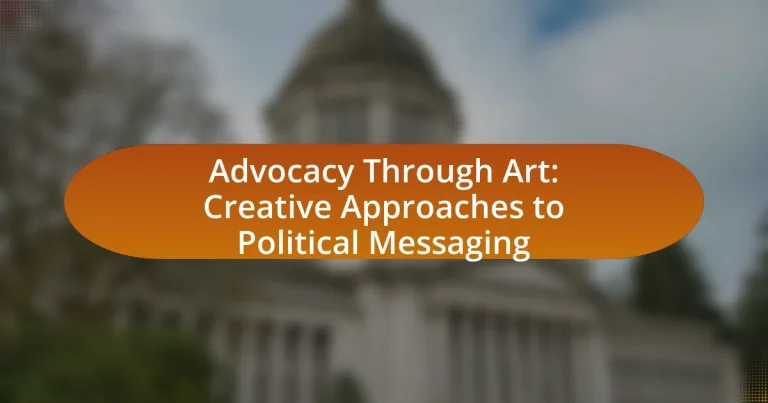Advocacy Through Art refers to the use of artistic expression to promote social, political, or environmental causes, employing various art forms such as visual arts, music, theater, and literature to raise awareness and inspire action. The article explores how art serves as a medium for political messaging, highlighting historical examples and the effectiveness of different art forms in conveying complex ideas. It discusses the importance of advocacy through art in contemporary society, the challenges artists face, and the ethical considerations involved in political advocacy. Additionally, it provides practical tips for artists on effective political messaging and collaboration with advocacy organizations, along with resources available for those interested in engaging in political advocacy through their art.

What is Advocacy Through Art?
Advocacy Through Art is the use of artistic expression to promote social, political, or environmental causes. This approach leverages various art forms, such as visual arts, music, theater, and literature, to raise awareness, inspire action, and influence public opinion on critical issues. For instance, the AIDS Memorial Quilt, which visually represents the impact of the AIDS crisis, has been instrumental in advocating for awareness and policy change regarding HIV/AIDS. This demonstrates how art can serve as a powerful tool for advocacy by engaging audiences emotionally and intellectually, thereby fostering a deeper understanding of complex societal challenges.
How does art serve as a medium for political messaging?
Art serves as a medium for political messaging by conveying complex ideas and emotions in a visually impactful way. Through various forms such as paintings, sculptures, and performance art, artists can express dissent, raise awareness, and inspire action on political issues. For example, the works of artists like Banksy often critique social injustices and government policies, effectively reaching a wide audience and sparking dialogue. Historical instances, such as Picasso’s “Guernica,” illustrate how art can respond to political events, capturing public sentiment and influencing perceptions. This ability to communicate messages succinctly and powerfully makes art a vital tool in political advocacy.
What are the historical examples of art used in political advocacy?
Historical examples of art used in political advocacy include the works of artists like Diego Rivera, whose murals depicted social and political themes, particularly in Mexico during the early 20th century. Rivera’s mural “Man at the Crossroads” was commissioned for the Rockefeller Center in 1933 and illustrated class struggle and the potential for social change, although it was ultimately destroyed due to its controversial content. Another significant example is the use of propaganda posters during World War I and II, such as the iconic “We Can Do It!” poster featuring Rosie the Riveter, which promoted women’s contributions to the war effort and women’s rights. Additionally, the Dada movement in the early 20th century, particularly through artists like Hannah Höch, used collage to critique societal norms and political issues, reflecting the chaos of post-war Europe. These examples demonstrate how art has historically served as a powerful medium for political advocacy, influencing public perception and mobilizing social movements.
How do different art forms convey political messages?
Different art forms convey political messages through symbolism, visual representation, and emotional engagement. For instance, visual arts like paintings and murals often use imagery to depict social injustices, as seen in Diego Rivera’s murals that addressed class struggles in Mexico. Similarly, literature, such as George Orwell’s “1984,” critiques totalitarianism through narrative and character development, illustrating the dangers of oppressive regimes. Music also serves as a powerful medium; protest songs like Bob Dylan’s “The Times They Are a-Changin'” mobilize public sentiment and inspire action against social issues. These examples demonstrate how various art forms effectively communicate political ideas and provoke thought, making them essential tools for advocacy and social change.
Why is advocacy through art important in contemporary society?
Advocacy through art is important in contemporary society because it serves as a powerful medium for social change and awareness. Art can transcend language barriers and communicate complex issues in an accessible manner, making it an effective tool for engaging diverse audiences. For instance, the use of street art and murals has been pivotal in movements like Black Lives Matter, where visual representation amplifies marginalized voices and fosters community dialogue. Research indicates that art can evoke emotional responses, prompting individuals to reflect on societal issues and inspiring action, as seen in campaigns like “The Art of Protest” which highlights the role of creativity in activism.
What role does art play in raising awareness about social issues?
Art serves as a powerful medium for raising awareness about social issues by engaging audiences emotionally and intellectually. Through various forms such as visual art, music, and performance, artists can highlight injustices, provoke thought, and inspire action. For instance, the “AIDS Memorial Quilt” effectively raised awareness about the AIDS crisis in the 1980s and 1990s, transforming personal loss into a collective call for action and understanding. This demonstrates how art can create a shared experience that fosters empathy and mobilizes communities around critical social issues.
How can art influence public opinion and policy change?
Art can influence public opinion and policy change by shaping perceptions and emotions, thereby mobilizing communities around specific issues. For instance, visual art, music, and performance can evoke strong emotional responses that resonate with audiences, making complex social issues more relatable and urgent. Historical examples include the impact of Picasso’s “Guernica,” which raised awareness about the horrors of war and influenced anti-war sentiments, ultimately contributing to policy discussions. Additionally, campaigns like “The AIDS Memorial Quilt” utilized art to humanize the epidemic, fostering public empathy and prompting legislative action for healthcare reforms. These instances demonstrate how art serves as a powerful tool for advocacy, effectively bridging the gap between individual experiences and broader societal change.

What are the creative approaches to political messaging through art?
Creative approaches to political messaging through art include visual storytelling, public installations, and performance art. Visual storytelling utilizes imagery and symbolism to convey complex political ideas, as seen in works like Picasso’s “Guernica,” which powerfully depicts the horrors of war. Public installations, such as the “Fearless Girl” statue facing the Wall Street bull, provoke dialogue about gender equality and corporate responsibility. Performance art, exemplified by artists like Marina Abramović, engages audiences in real-time, fostering emotional connections to political issues. These methods effectively communicate messages, mobilize communities, and inspire action by making political themes accessible and relatable.
How do artists choose themes for political advocacy?
Artists choose themes for political advocacy by reflecting on personal experiences, societal issues, and cultural contexts. They often draw inspiration from current events, historical injustices, or movements that resonate with their values. For instance, artists like Ai Weiwei focus on human rights violations, while others may address climate change or social inequality. This thematic selection is frequently influenced by the artist’s background, audience engagement, and the desire to provoke thought or inspire action. Research indicates that art can effectively communicate complex political messages, making it a powerful tool for advocacy.
What factors influence the selection of political themes in art?
The selection of political themes in art is influenced by societal context, artist intent, and audience reception. Societal context includes current events, cultural movements, and historical circumstances that shape public discourse, such as the civil rights movement influencing artists like Jacob Lawrence. Artist intent refers to the personal motivations and beliefs of the creator, which can drive the choice of themes, as seen in the works of Ai Weiwei, who addresses human rights issues. Audience reception is crucial, as the effectiveness of political art often depends on how it resonates with viewers, exemplified by the widespread impact of Banksy’s politically charged street art.
How do artists balance personal expression with political messaging?
Artists balance personal expression with political messaging by integrating their individual experiences and perspectives into broader social issues. This approach allows them to convey authentic emotions while addressing political themes, creating a resonance that engages audiences. For instance, artists like Ai Weiwei use personal narratives to highlight human rights abuses, effectively merging personal and political realms. This method not only personalizes the political message but also fosters a deeper connection with viewers, making the political discourse more relatable and impactful.
What techniques do artists use to engage audiences politically?
Artists engage audiences politically through techniques such as visual storytelling, satire, and participatory art. Visual storytelling allows artists to convey complex political narratives and evoke emotional responses, as seen in works like Picasso’s “Guernica,” which powerfully depicts the horrors of war. Satire employs humor and irony to critique political figures and policies, exemplified by the works of artists like Banksy, who uses street art to challenge societal norms. Participatory art invites audience involvement, fostering dialogue and reflection on political issues, as demonstrated by projects like “The People’s Choice” by artist Tania Bruguera, which encourages community engagement in political discourse. These techniques effectively raise awareness and provoke thought, making art a potent medium for political engagement.
How does visual storytelling enhance political messages in art?
Visual storytelling enhances political messages in art by creating an emotional connection that transcends language barriers. This method allows artists to convey complex political themes through imagery, symbols, and narratives, making the messages more accessible and impactful. For instance, the use of powerful visuals in works like Picasso’s “Guernica” effectively communicates the horrors of war and the suffering of civilians, influencing public perception and political discourse. Studies show that visual content is processed 60,000 times faster than text, which underscores its effectiveness in capturing attention and evoking emotional responses, thereby amplifying the political message.
What role does symbolism play in political art?
Symbolism plays a crucial role in political art by conveying complex ideas and emotions succinctly. Political artists utilize symbols to represent ideologies, movements, or social issues, allowing viewers to engage with the artwork on a deeper level. For instance, the use of the dove as a symbol of peace in various artworks communicates anti-war sentiments effectively. Historical examples include Picasso’s “Guernica,” which uses distorted figures and monochromatic tones to symbolize the horrors of war and the suffering of civilians. Such symbolism not only enhances the emotional impact of the art but also fosters dialogue and reflection on political issues, making it a powerful tool for advocacy and social change.

What are the challenges and criticisms of advocacy through art?
Advocacy through art faces several challenges and criticisms, primarily related to its effectiveness, accessibility, and potential for misinterpretation. Critics argue that art may not always convey clear political messages, leading to ambiguity that can dilute the intended advocacy. Additionally, the elitism associated with certain art forms can limit accessibility, alienating marginalized communities that advocacy aims to support. Furthermore, the subjective nature of art means that interpretations can vary widely, sometimes resulting in backlash or misunderstanding of the artist’s intent. For instance, the use of provocative imagery can provoke controversy rather than foster dialogue, as seen in various political art movements throughout history. These factors contribute to ongoing debates about the role and impact of art in social and political advocacy.
What are the potential pitfalls of using art for political purposes?
Using art for political purposes can lead to several potential pitfalls, including misinterpretation, oversimplification, and alienation of audiences. Misinterpretation occurs when the intended message of the artwork is not understood as the creator envisioned, which can dilute the political impact. For example, the use of ambiguous symbols may confuse viewers, leading to varied interpretations that stray from the original political intent. Oversimplification happens when complex political issues are reduced to simplistic visuals, failing to capture the nuances necessary for informed discourse. This can result in a lack of depth in public understanding, as seen in some protest art that prioritizes shock value over substantive critique. Additionally, art that is perceived as too partisan can alienate segments of the audience, limiting its reach and effectiveness. Historical instances, such as the backlash against certain politically charged artworks in museums, illustrate how art can polarize rather than unite, ultimately undermining its advocacy potential.
How can art be misinterpreted in political contexts?
Art can be misinterpreted in political contexts when its symbolism or intent is misunderstood by audiences, leading to divergent interpretations. For instance, a piece intended as a critique of a regime may be perceived as support for that regime if the audience lacks contextual knowledge or if the imagery is ambiguous. Historical examples include Pablo Picasso’s “Guernica,” which was initially misinterpreted by some as a glorification of war rather than a condemnation of violence during the Spanish Civil War. This misinterpretation can occur due to cultural differences, lack of familiarity with the artist’s background, or the political climate influencing public perception. Such misunderstandings can significantly alter the impact of the artwork, potentially undermining its intended message and leading to unintended political consequences.
What are the ethical considerations for artists in political advocacy?
Artists engaging in political advocacy must consider the ethical implications of their work, including the responsibility to represent marginalized voices accurately and the potential for misinterpretation of their messages. Ethical considerations also involve the risk of perpetuating stereotypes or biases, as seen in historical instances where art has been used to manipulate public perception, such as propaganda during wartime. Furthermore, artists must navigate the balance between personal expression and the broader impact of their work on society, ensuring that their advocacy does not inadvertently harm the communities they aim to support.
How do artists navigate censorship and backlash?
Artists navigate censorship and backlash by employing various strategies such as using metaphor, satire, and ambiguity in their work. These techniques allow them to convey their messages while minimizing the risk of direct confrontation with authorities or audiences that may oppose their views. For instance, artists like Ai Weiwei have utilized symbolism and indirect references to critique political regimes, effectively communicating dissent without overtly violating censorship laws. Additionally, many artists engage in community building and collaboration, creating networks that support and amplify their voices, which can provide a buffer against backlash. Historical examples, such as the works of the Guerrilla Girls, demonstrate how collective action and anonymity can protect individual artists while still addressing controversial topics.
What strategies can artists employ to protect their work?
Artists can employ copyright registration as a primary strategy to protect their work. By registering their artwork with the U.S. Copyright Office, artists establish a public record of their ownership, which provides legal advantages in case of infringement. Additionally, artists can use digital watermarking to embed identifying information within their digital works, making it easier to prove ownership and track unauthorized use. Furthermore, utilizing contracts and licensing agreements when collaborating or selling their work can help clarify rights and usage terms, thereby safeguarding their creative output. These strategies collectively enhance an artist’s ability to maintain control over their intellectual property and mitigate the risk of unauthorized exploitation.
How can artists respond to criticism while maintaining their message?
Artists can respond to criticism while maintaining their message by actively engaging with the feedback and using it to refine their work without compromising their core values. This approach allows artists to demonstrate resilience and adaptability, which can enhance their credibility and connection with their audience. For instance, artists like Ai Weiwei have faced significant criticism yet continued to address social and political issues through their art, illustrating that constructive dialogue can coexist with a strong artistic vision. By acknowledging criticism and incorporating relevant aspects into their narrative, artists can strengthen their message and foster a deeper understanding of their work among viewers.
What practical tips can artists follow for effective political messaging?
Artists can enhance their political messaging by focusing on clarity, emotional resonance, and audience engagement. Clear messaging ensures that the intended political message is easily understood, while emotional resonance helps to connect with the audience on a personal level, making the message more impactful. Engaging the audience through interactive elements or community involvement can foster a deeper connection and encourage dialogue. For instance, the use of social media platforms allows artists to reach wider audiences and facilitate discussions around their work, as seen in campaigns like #BlackLivesMatter, which effectively utilized art to convey powerful political messages.
How can artists effectively collaborate with advocacy organizations?
Artists can effectively collaborate with advocacy organizations by aligning their creative vision with the organization’s mission and goals. This alignment allows artists to create impactful works that resonate with the advocacy’s message, enhancing visibility and engagement. For instance, artists can participate in campaigns, create public art installations, or develop multimedia projects that highlight specific social issues, thereby amplifying the organization’s voice. Research shows that collaborations between artists and advocacy groups can lead to increased public awareness and community involvement, as seen in initiatives like the “Art for Change” program, which successfully mobilized artists to address climate change through visual storytelling.
What resources are available for artists interested in political advocacy?
Artists interested in political advocacy can access various resources, including organizations, grants, and online platforms. Organizations such as the Creative Capital Foundation provide funding and support for artists engaged in social change, while the National Endowment for the Arts offers grants specifically for projects that address community issues. Additionally, online platforms like Artivism and the Center for Artistic Activism provide tools, workshops, and networking opportunities to help artists develop their advocacy skills. These resources empower artists to effectively use their work to influence political discourse and engage with social issues.


